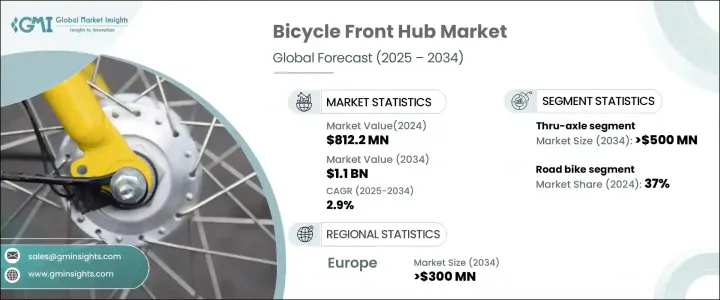
세계의 자전거 프론트 허브 시장은 2024년 8억 1,220만 달러로 평가되었으며, 2025년부터 2034년까지 연평균 성장률(CAGR) 2.9%로 성장할 것으로 예측됩니다. 이러한 성장은 허브 기술의 발전과 전기 자전거(e-bike) 및 도시 모빌리티 솔루션의 인기 급증에 힘입어 고성능 자전거에 대한 수요가 증가함에 따라 촉진되고 있습니다. 이 시장은 허브의 성능과 내구성을 크게 향상시키는 경량 소재, 첨단 결합 시스템, 밀폐형 베어링과 같은 혁신의 혜택을 누리고 있습니다. 전 세계 정부가 자전거 인프라 개선을 지속적으로 지원함에 따라 자전거, 특히 전기 자전거에 대한 수요는 계속 증가하고 있습니다. 이와 함께 애프터마켓 커스터마이징 및 교체에 대한 수요가 증가하는 추세도 시장 확대에 기여하고 있습니다. 이러한 요인들은 더욱 역동적이고 진화하는 시장을 위한 기반을 마련하고 있습니다.

보다 지속 가능한 교통수단에 대한 요구와 레크리에이션 활동으로서 자전거 타기의 인기가 높아지면서 더욱 발전된 자전거 허브에 대한 필요성이 커지고 있습니다. 도시 모빌리티 트렌드가 전기 자전거로 변화함에 따라 전기 자전거의 증가된 출력과 하중을 처리할 수 있는 프론트 허브에 대한 수요도 계속 증가하고 있습니다. 전기 자전거 프론트 허브는 모터의 무게를 지탱할 뿐만 아니라 장시간 사용에도 견딜 수 있는 내구성과 성능을 제공해야 합니다. 이러한 변화로 인해 라이딩 경험의 효율성과 편안함을 모두 향상시키는 솔루션을 선택하는 사이클리스트가 늘어나면서 업계가 변화하고 있습니다.
| 시장 범위 | |
|---|---|
| 시작 연도 | 2024년 |
| 예측 연도 | 2025-2034년 |
| 시작 금액 | 8억 1,220만 달러 |
| 예측 금액 | 11억 달러 |
| CAGR | 2.9% |
자전거 프론트 허브 시장은 제품 유형별로 퀵 릴리스, 스루액슬, 볼트온 허브로 분류됩니다. 스루액슬 허브는 뛰어난 강성, 강도, 휠 안전성으로 인해 특히 고성능 자전거에서 각광받고 있습니다. 이러한 특징 덕분에 안정성과 정밀도가 중요한 산악 자전거, 그래블 자전거, 전기 자전거에 특히 적합합니다.
자전거 유형에 따라 시장은 하이브리드 자전거, 산악 자전거, 전기 자전거, 로드 자전거로 나뉩니다. 로드 자전거는 2024년 37%의 시장 점유율을 차지했으며, 경량 고성능 허브에 대한 수요가 증가했습니다. 탄소 섬유와 알루미늄과 같은 소재의 발전이 이러한 트렌드를 주도하고 있으며, 향상된 베어링 시스템과 빠른 체결 메커니즘은 이제 표준이 되었습니다.
유럽은 2024년 세계의 자전거 프론트 허브 시장 점유율의 29%를 차지했으며, 2034년까지 3억 달러를 창출할 것으로 예상됩니다. 경기 변동과 소비자 선호도 변화와 같은 어려움에도 불구하고 프론트 허브를 비롯한 고성능 자전거 부품에 대한 수요는 여전히 탄력적입니다. 이 지역에서 전기 자전거의 보급이 증가함에 따라 현대 사이클리스트의 진화하는 수요를 충족하기 위한 허브 기술의 혁신이 더욱 촉진되고 있습니다.
The Global Bicycle Front Hub Market was valued at USD 812.2 million in 2024 and is projected to grow at a CAGR of 2.9% from 2025 to 2034. This growth is driven by increasing demand for high-performance bicycles, spurred by advancements in hub technology and the surge in popularity of electric bikes (e-bikes) and urban mobility solutions. The market benefits from innovations such as lightweight materials, advanced engagement systems, and sealed bearings, which significantly enhance hub performance and durability. As governments worldwide continue to support cycling infrastructure improvements, the demand for bicycles-especially e-bikes-continues to grow. Alongside this, a growing trend toward aftermarket customization and replacement further contributes to the market's expansion. These factors are paving the way for a more dynamic and evolving market.

The push for more sustainable transportation, coupled with the rising popularity of cycling as a recreational activity, is driving the need for more advanced bicycle hubs. As urban mobility trends shift in favor of e-bikes, the demand for front hubs capable of handling the increased power and load of these vehicles continues to rise. E-bike front hubs must not only support the weight of the motor but also provide durability and performance for extended usage. This shift is changing the industry, with more cyclists opting for solutions that enhance both the efficiency and comfort of their riding experience.
| Market Scope | |
|---|---|
| Start Year | 2024 |
| Forecast Year | 2025-2034 |
| Start Value | $812.2 Million |
| Forecast Value | $1.1 Billion |
| CAGR | 2.9% |
The bicycle front hub market is segmented by product type into quick-release, thru-axle, and bolt-on hubs. In 2024, the thru-axle segment captured 47% of the market share and is expected to generate USD 500 million by 2034. Thru-axle hubs are gaining traction, particularly in high-performance bicycles, thanks to their superior stiffness, strength, and wheel security. These features make them especially suitable for mountain bikes, gravel bikes, and e-bikes, where stability and precision are crucial. The shift toward thru-axle systems is becoming the industry standard, driven by the desire for enhanced handling and more stable rides.
In terms of bicycle types, the market is divided into hybrid bikes, mountain bikes, e-bikes, and road bikes. Road bikes held a 37% market share in 2024, with demand rising for lightweight, high-performance hubs. Advancements in materials such as carbon fiber and aluminum are driving these trends, while improved bearing systems and quick engagement mechanisms are now standard. Road cyclists, increasingly focused on aerodynamics and speed, seek hubs that offer lower friction and greater responsiveness.
Europe accounted for 29% of the global bicycle front hub market share in 2024 and is projected to generate USD 300 million by 2034. Despite challenges like economic fluctuations and evolving consumer preferences, demand for high-performance bicycle components, including front hubs, remains resilient. The growing adoption of e-bikes in the region is further driving innovation in hub technology to meet the evolving demands of modern cyclists.